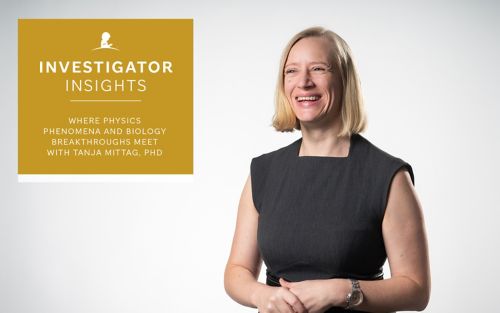St. Jude Family of Websites
Explore our cutting edge research, world-class patient care, career opportunities and more.
St. Jude Children's Research Hospital Home

- Fundraising
St. Jude Family of Websites
Explore our cutting edge research, world-class patient care, career opportunities and more.
St. Jude Children's Research Hospital Home

- Fundraising
Where physics phenomena and biology breakthroughs meet

Tanja Mittag, PhD, St. Jude Department of Structural Biology, investigates the underlying principles behind biomolecular condensation, a process at the center of a growing list of biological function and dysfunction.
In science, there is a perceived chasm between physics and biology; these can seem like different disciplines with objectives that are far apart. However, my postdoctoral advisor, Julie Forman-Kay, PhD, at the Hospital for Sick Children, was excellent at closing that gap; she is — and was — always working closely with biologists. This was absolutely fascinating for me and when I realized the promise of biophysics: to answer fundamental biological questions with the help of specific experiments rooted in physics.
My postdoctoral project combined biophysical techniques with biochemistry to investigate the amino acid sequence of intrinsically disordered proteins (IDPs). IDPs are proteins without fixed structure, but we wanted to see how the amino acid sequence does, in fact, encode structural properties that then give rise to functional properties. Working closely with biologists asking relevant biological questions was an important part of this work.
Since then, understanding the scientific phenomena that occur where biology and physics intersect has driven my scientific curiosity. This approach, this way of thinking, is what I have taken with me into my lab, and it is at the center of what we are doing as a team here at St. Jude.
Developing insights from the ground up
St. Jude is a fantastic place to do this kind of work because it brings together people from the biological side, focused on cancer or other diseases, with people focused on biophysics and structural biology, looking for physics-based mechanisms underlying disease. The concentration of these diverse types of expertise, combined with a fantastic level of infrastructure support, enables us to do incredibly deep work to uncover insights that bring all sides of the research enterprise together. I enjoy that we can make true our promise to use biophysics to answer fundamental biological questions.
My lab focuses on understanding interactions between IDP individuals or pairs (and also folded proteins) and the consequences of these interactions. We find that the biophysical properties of the simple systems we characterize in vitro (outside living organisms) often apply in vivo (inside living organisms), too. The simple biophysics at work often gives rise to the biological function in question.
An example of this, and one I am keenly interested in, is biomolecular phase separation, which deals with the formation of membrane-less compartments in cells called condensates. It has become clear that we need to pay attention to the underlying biophysics of condensates, such as the interactions between IDPs, as they are key to understanding what drives phase separation in cells. In my lab, we want to understand at a fundamental level the kinds of properties that give rise to condensates and how amino acid sequences can determine if a condensate is a liquid or closer to putty. Then, we can take this understanding to interrogate how condensates influence healthy cell function or disease processes.
Collaboration bridges between biophysics and biology
While fundamental understanding is core to everything we do, we give context to this understanding when we apply it to pathways related to cancer and neurodegenerative disease. By working with collaborators who bring biological disease expertise and developing a language shared between biophysicists and biologists, we can address diverse sets of problems and get to the biophysical processes that underlie these illnesses in ways purely biophysical or biological approaches in a vacuum would not.
Long-term collaborations are essential for this. They provide time to develop that shared language. Thankfully, there are initiatives at St. Jude leading the way when it comes to collaboration in science, such as the Collaborative Research Consortium on the Biology and Biophysics of RNP Granules and the new Structural Cell Biology Initiative. This type of strategic planning positions our efforts to characterize biophysical processes in living beings and cells as a vital component of everything we do here at St. Jude.






